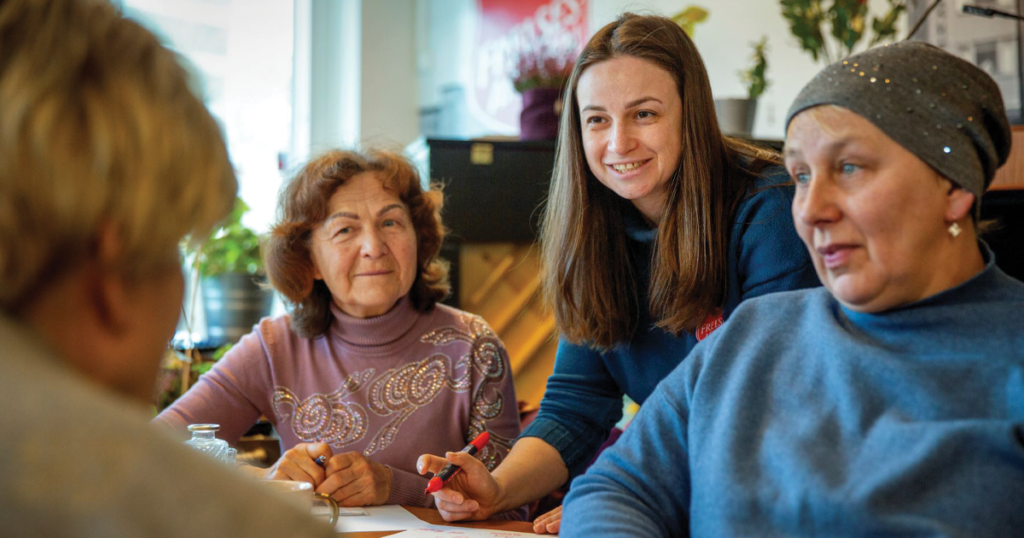1 Year Anniversary
A look at The Salvation Army’s continuing ministry in Ukraine.
Earlier this year, at The Salvation Army’s National Headquarters in Alexandria, VA, a Ukrainian flag was presented during a weekly chapel service in honor of the work that has been done and the ongoing relief efforts in Ukraine. The flag was signed by Convoy of Hope team members, who have partnered with The Salvation Army to deliver relief supplies to displaced people. Since the conflict in Ukraine broke out in February of 2022, Salvation Army officers, employees and volunteers from around the world have been helping in a variety of ways, both on the frontlines and in other regions.
Tameka Sharp, technical advisor for international disaster response and recovery in The Salvation Army World Service Office (SAWSO), is one such person. Members of The War Cry team had the privilege of sitting with Sharp, who provided details about the work that’s been done on behalf of the Ukrainian people since the beginning of the crisis.
When asked about what kind of work the Army has been doing in Ukraine, Sharp started by confirming that at various points throughout the conflict, more than 20 neighboring European countries assisted in responding to the needs of the Ukrainian people. A majority of the efforts have been primarily focused on providing “life-sustaining aid.” That means basic necessities, such as food, clean water and clothing. Other common needs are hygiene kits, back-to-school gear and baby supplies, which are highly sought after. Sharp also said that in everything the Army is doing, they’ve includes an anti-human trafficking element, as refugees are particularly susceptible to that industry. Notably, there has also been some ongoing camp ministry involved in the Ukraine relief. Alongside summer and winter camp programs for kids, camps have served as retreats for the staff and officers working on the frontlines, where they can relax, receive some care, and have the opportunity to debrief and fellowship. Sharp said that these camps provide “a way of offering psychosocial support in a safe environment and fun activities” for both the workers and the kids.

Throughout the conversation, Sharp continued to reiterate that the highest priority in the response efforts is still providing food to refugees. To that end, The Salvation Army has fostered a partnership with Convoy of Hope, another faith-based organization whose goal is to “feed the world through children’s feeding initiatives, community outreach, and disaster response.” Both The Salvation Army and Convoy of Hope are members of National Voluntary Organizations Active in Disasters, a US-based group of organizations that coordinate on disaster relief, and Christian Relief Cooperation, a smaller group of Christian organizations that collaborate during disasters. While representing the Army on various committees in these groups, Sharp met Stacy Lamb, the Vice President of Disaster Relations at Convoy of Hope. When the time came to expand the Army’s reach into Ukraine, particularly with food, Sharp knew who to call.
The partnership has been primarily focused on food. With an already-established network and delivery infrastructure, Convoy of Hope has been able to distribute food anywhere in Europe where The Salvation Army is supporting Ukrainian refugees. Convoy of Hope determines what the food needs are in any given area, SAWSO supports the efforts financially through its donors—paying vendors directly when possible and reimbursing Convoy of Hope when it’s not—and then Convoy of Hope delivers the food. Additionally, both groups are careful to source the goods from local vendors, which is not only more cost-efficient and environmentally friendly than international shipping, but also ensures food that is familiar and liked by the people who need it.
The Army’s partnership with Convoy of Hope has produced incredible results and bodes well for the future of disaster relief. Sharp is hopeful that when another disaster occurs, The Salvation Army will be the first organization Convoy of Hope calls, and vice versa. And while the partnership has primarily been with SAWSO and the US branch of The Salvation Army, Sharp wants the rest of the Army world to recognize the benefits of this partnership and be open to working together. And after seeing the evidence, it’s certainly possible.
If you would like to get involved in the Ukraine relief effort or any other missions that SAWSO is pursuing, you can visit sawso.org to donate or get more information on ongoing projects in Ukraine and other countries. SAWSO is also on Twitter, Facebook and LinkedIn. The conflict in Ukraine is an ongoing reality for all residents, including those who are displaced in border countries. The needs are still there. Stay aware and stay up to date so that we can continue to do the most good.
The Salvation Army has provided:
- 3,710,067 cooked meals
- 198,401 vouchers
- 129,293 non-food items
- 111,174 food parcels
- 84,350 hygiene kits
- 41,912 instances of educational assistance for human trafficking prevention
- 20,220 instances of mental health/pastoral care support
Based on a report by the Salvation Army World Service Organization.







